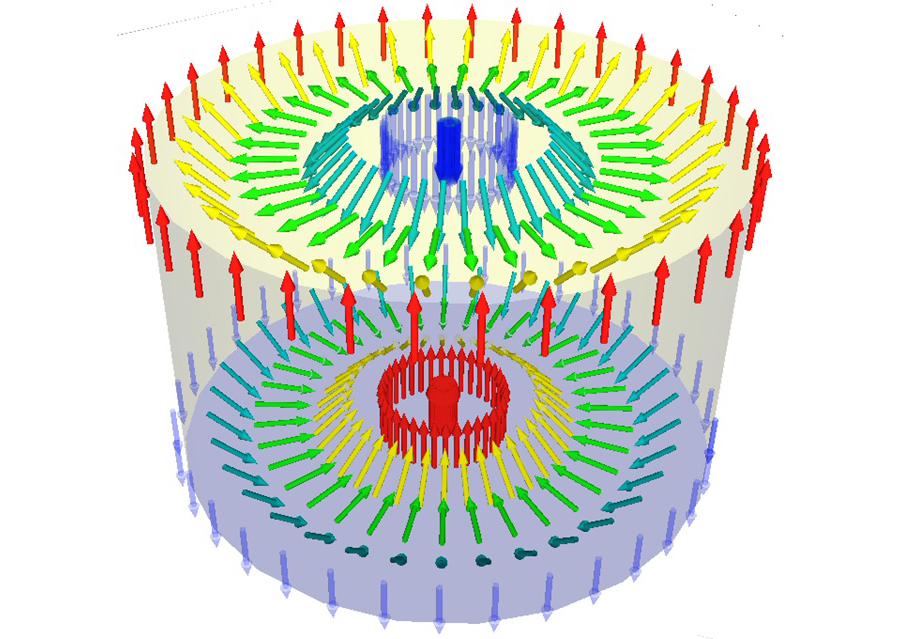
Magnetic whirls pave the way for energy-efficient computing
International research collaboration involving the University of the Konstanz has been able to increase the diffusion of magnetic whirls – the skyrmions – by a factor of ten
In today's world, our lives are unimaginable without computers. Up until now, these devices process information using primarily electrons as charge carriers, with the components themselves heating up significantly in the process. As a result, active cooling is required, which comes with high energy costs. Spintronics aims to solve this problem: Instead of utilizing the electron flow for information processing, it relies on their spin – their intrinsic angular momentum. This approach is expected to have a positive impact on the size, speed and sustainability of computers.
Magnetic whirls store and process information
Science often does not simply consider the spin of an individual electron, but rather magnetic whirls composed of numerous spins. These whirls called skyrmions emerge in magnetic metallic thin layers and can be considered as two-dimensional quasi-particles. On the one hand, the whirls can be deliberately moved by applying a small electric current to the thin layers; on the other hand, they move randomly and extremely efficiently due to diffusion. The feasibility of creating a functional computer based on skyrmions was demonstrated by a team of researchers from Johannes Gutenberg University Mainz (JGU), led by Professor Mathias Kläui, using an initial prototype. This prototype consisted of thin, stacked metallic layers, some only a few atomic layers thick.
Energy efficiency: tenfold increase in whirl diffusion
As published in the current issue of Nature Communications, the University of Konstanz's research collaboration with Mainz University, Germany, and Tohoku University, Japan, has now achieved another step towards spin-based, unconventional computing: They were able to increase the diffusion of skyrmions by a factor of about ten using synthetic antiferromagnets, which drastically reduces the energy consumption and increases the speed of such a potential computer. "The reduction of energy usage in electronic devices is one of the biggest challenges in fundamental research", emphasized Professor Ulrich Nowak, who led the theoretical part of the project in Konstanz.
What is an antiferromagnet?
Normal ferromagnets consist of many small spins, all coupled together to point in the same direction, thereby creating a large magnetic moment. In antiferromagnets, the spins are aligned alternatingly antiparallel, i.e. a spin and its direct neighbours point in the opposite direction. As a result, there is no net magnetic moment, even though the spins remain antiferromagnetically well-ordered. Antiferromagnets have significant advantages, such as a thousand times faster dynamics for switching, better stability and the potential for higher storage densities.
Why use antiferromagnets?
When skyrmions move very rapidly, an additional force component arises in ferromagnetic layers perpendicular to the direction of motion. This force component pushes the skyrmions off course. Consequently, they collide with the wall, get stuck and obstruct the path for others. At higher speeds, they can even be destroyed. However, it is theoretically known that this effect either does not occur in antiferromagnets or it occurs to a very limited extent.
To artificially create such an antiferromagnet, the researchers coupled two of their ferromagnetic layers in a way that the magnetization in the two layers is precisely aligned in opposite directions, cancelling out their magnetic fields. This reduces the force that pushes the whirls out of their trajectory.
Stochastic computing
The researchers have created a synthetic antiferromagnet in which the diffusion of skyrmions is approximately ten times higher than in the individual layers. This diffusion can be implemented to realize stochastic computing – a form of computing where stochastic processes like the random motion of particles are utilized.
The role fluctuations play for the motion of skyrmions is studied in Konstanz in the context of the Collaborative Research Centre SFB1432. The interrelationships are complex, and only with the help of computer simulations is it possible to separate and thus understand the various effects that occur.
Key facts
- Original publication T. Dohi et al., Enhanced thermally-activated skyrmion diffusion with tunable effective gyrotropic force, Nature Communications, 11 September 2023, DOI: 10.1038/s41467-023-40720-0
- Research collaboration between the University of Konstanz, Johannes Gutenberg University Mainz, both Germany, and Tohoku University, Japan, could increase the diffusion of skyrmions by a factor of about ten using synthetic antiferromagnets, thus drastically reducing the energy consumption of spin-based non-conventional computing.
- Funded by the German Research Foundation (DFG) in the framework of the Collaborative Research Centre (SFB) "Fluctuations and Nonlinearities in Classical and Quantum Matter beyond Equilibrium" (SFB1432) at the University of Konstanz, SFB "Spin+X" (SFB/TRR 173) at the University of Kaiserslautern-Landau and the Johannes Gutenberg University Mainz, and by the Priority Programme SPP 2137: "Skyrmionics: Topological Spin Phenomena in Real-Space for Applications".

